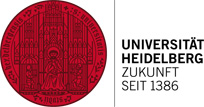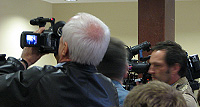How Did the Universe Begin: Hot Big Bang or Slow Thaw?
25 February 2014

ESA and the Planck Collaboration (Copyright)
Photo-Download
Did the universe begin with a hot Big Bang or did it slowly thaw from an extremely cold and almost static state? Prof. Dr. Christof Wetterich, a physicist at Heidelberg University, has developed a theoretical model that complements the nearly 100-year-old conventional model of cosmic expansion. According to Wetterich’s theory, the Big Bang did not occur 13.8 billion years ago – instead, the birth of the universe stretches into the infinite past. This view holds that the masses of all particles constantly increase. The scientist explains that instead of expanding, the universe is shrinking over extended periods of time.
Cosmologists usually call the birth of the universe the Big Bang. The closer we approach the Big Bang in time, the stronger the geometry of space and time curves. Physicists call this a singularity – a term describing conditions whose physical laws are not defined. In the Big Bang scenario, the spacetime curvature becomes infinitely large. Shortly after the Big Bang, the universe was extremely hot and dense. Prof. Wetterich believes, however, that a different “picture” is also possible. If the masses of all elementary particles grow heavier over time and gravitational force weakens, the universe could have also had a very cold, slow start. In that view, the universe always existed and its earliest state was virtually static, with the Big Bang stretching over an infinitely long time in the past. The scientist from the Institute for Theoretical Physics assumes that the earliest “events” that are indirectly observable today came to pass 50 trillion years ago, and not in the billionth of a billionth of a billionth of a second after the Big Bang. “There is no longer a singularity in this new picture of the cosmos,” says Prof. Wetterich.

Photo: Benjamin
His theoretical model explains dark energy and the early “inflationary universe” with a single scalar field that changes with time, with all masses increasing with the value of this field. “It’s reminiscent of the Higgs boson recently discovered in Geneva. This elementary particle confirmed the physicists’ assumption that particle masses do indeed depend on field values and are therefore variable,” explains the Heidelberg scientist. In Wetterich’s approach, all masses are proportional to the value of the so-called cosmon field, which increases in the course of cosmological evolution. “The natural conclusion of this model is a picture of a universe that evolved very slowly from an extremely cold state, shrinking over extended periods of time instead of expanding,” explains Prof. Wetterich.
Wetterich stresses that this in no way renders the previous view of the Big Bang “invalid”, however. “Physicists are accustomed to describing observed phenomena using different pictures.” Light, for example, can be depicted as particles and as a wave. Similarly, his model can be seen as a picture equivalent to the Big Bang. “This is very useful for many practical predictions on the consequences that arise from this new theoretical approach. However, describing the ‘birth’ of the universe without a singularity does offer a number of advantages,” emphasises Prof. Wetterich. “And in the new model, the nagging dilemma of ‘there must have been something before the Big Bang’ is no longer an issue.”
Publications:
C. Wetterich: Hot big bang or slow freeze? arXiv:1401.5313 [astro-ph.CO]
C. Wetterich: Variable gravity Universe, Physical Review D 89, 024005 (6 January 2014), doi: 10.1103/PhysRevD.89.024005
C. Wetterich: Universe without expansion, Physics of the Dark Universe, Vol 2, Iss 4 (December 2013), 184-187, doi: 10.1016/j.dark.2013.10.002

